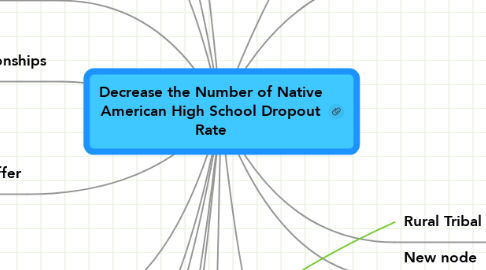Decrease the Number of Native American High School Dropout Rate
by Trudy Grantsen


1. My Educational Challenge Solution
1.1. parent & community participation in curriculum planning
1.2. develop partnerships with local community centers
1.3. develop partnerships with other tribal communities nationally & globally
1.4. Gain the skills & confidence to partake in the social, political, & economical transformations within the community
1.5. Design an experimental curriculum for a cohort of high school students in a rural tribal community
1.6. Recruit the members from the community, graduate students, and from other tribal commuities
2. Native American Education involves
2.1. parents
2.2. students
2.3. families
2.4. community
2.5. culture & language
2.6. understanding the history of the people
2.7. trust and relationships
2.8. reserving the traditional teachings
2.9. decolonization
2.10. nation building
2.11. economic development
2.12. social & health welfare
2.13. constitutional reform
2.14. gangs, violence, drugs, & alcohol
2.15. water & land rights
2.16. social self-sufficiency
2.17. civil rights
2.18. cultural identity
3. Urban Tribal Communities
4. Partner Network
4.1. colleges & universities
4.2. tribal & non-tribal communities
4.3. tribal & non-tribal schoools
4.4. rural & urban community centers
5. Key Activities
5.1. curriculum design
5.2. partnerships
5.3. proposal design
5.4. building & sustaining relationships
6. Key Resources
6.1. state & federal government
6.2. donations & grants
6.3. tribal leased resources
7. Cost Structure
7.1. recruitment of qualified Native American teachers
7.2. buses to transport students in rural areas
7.3. vans/buses to transport parents to meetings regarding curriculum
8. Offer
8.1. customized, quality education
8.2. empowerment
8.3. confidence
8.4. knowledge & skills
8.5. connectivity & production
9. Customer Relationships
9.1. personal
9.2. mentor
9.3. cultural
10. Distribution Channels
10.1. face-to-face
10.2. online
10.3. internships/service learning with communities
11. Revenue Stream
11.1. US federal - BIA
11.2. US state
11.3. Tribal revenues from casinos & resources
11.4. Shared resources (between tribes)
11.5. Tribal Goverment
12. Customer Segments
12.1. students
12.2. parents
12.3. tribal & non-tribal communities
12.4. teachers
12.5. administrators
13. direct application & learning service learning opportunities
14. Existing Successful Initiatives
14.1. Menominee Indian School District's Freshmen Academy
14.2. Everett Community College's Running Start program
14.3. NAYA Early College Academy
14.4. ASU's American Dream Academy
14.5. Parent Engagement
14.5.1. Workshops
14.5.2. Open Dialogue
14.5.3. Building Trust
14.5.4. Active Member
14.5.5. Empowerment & Building Confidence
14.6. Partnerships with colleges/universities
14.6.1. redefining relationships & building new pathways
14.6.2. Learn to be cultural & language sensitivity & responsive
14.6.3. building sustaining relationships
14.7. Teacher & Administrator Community Outreach
14.7.1. Building Trust & Relationships
14.7.2. Collaborating directly with parents & community
14.7.3. Finding new ways to build academic bridges
14.7.4. See Parents/Student as Learning Partners
14.7.5. Modeling Community Support
